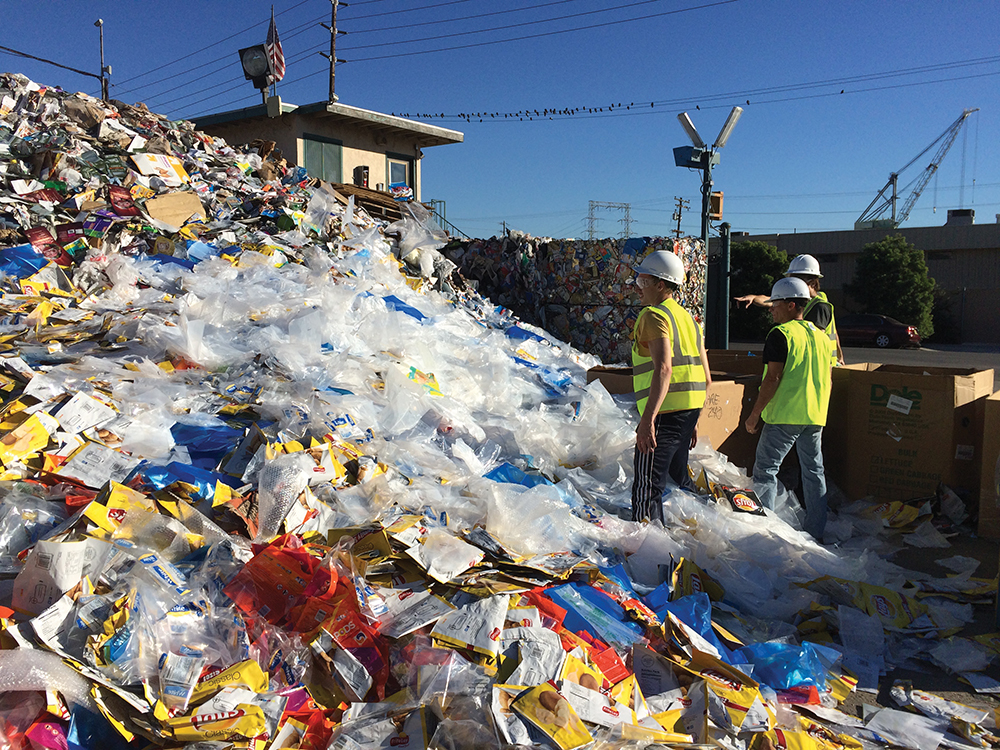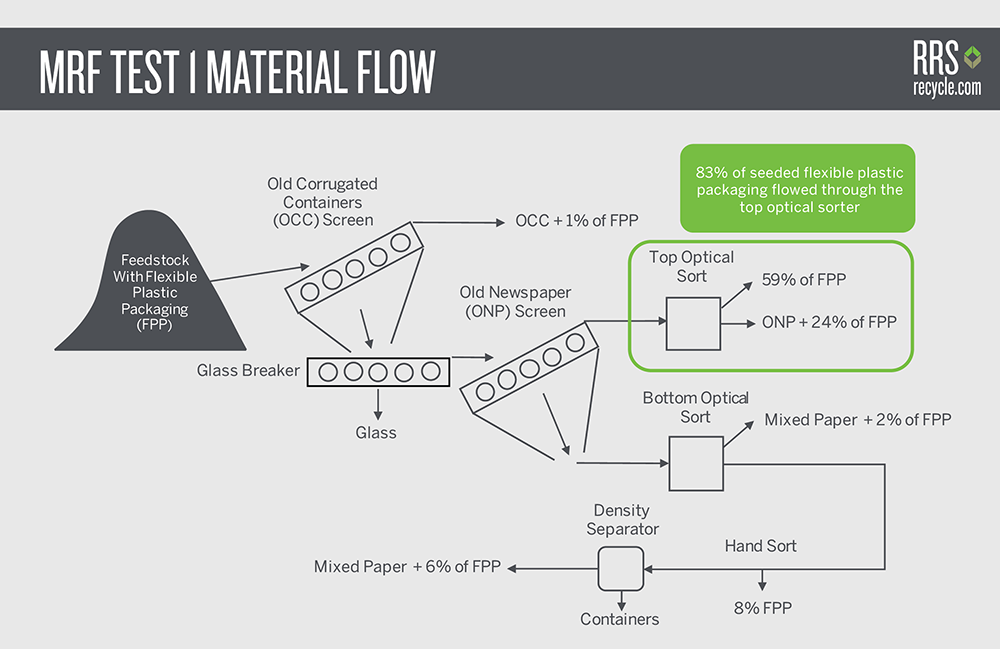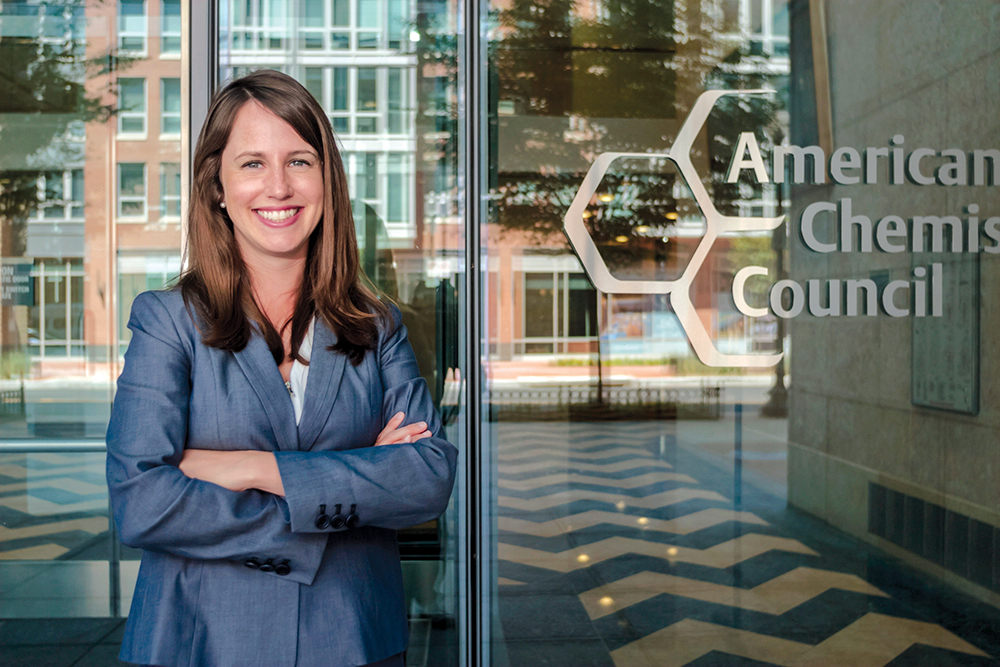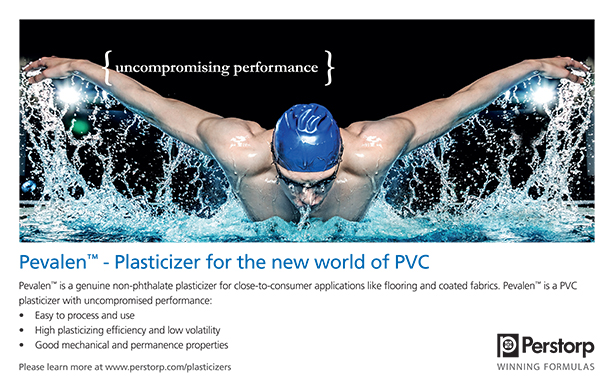New Research Shows Potential to Recycle Flexible Packaging Using Existing Technology
Previous Article Next Article
By American Chemistry Council
New Research Shows Potential to Recycle Flexible Packaging Using Existing Technology
Previous Article Next Article
By American Chemistry Council
New Research Shows Potential to Recycle Flexible Packaging Using Existing Technology
Previous Article Next Article
By American Chemistry Council

Seeding of flexible plastic packaging into single-stream feedstock by research team members prior to mixing. Courtesy of Materials Recovery for the Future

Seeding of flexible plastic packaging into single-stream feedstock by research team members prior to mixing. Courtesy of Materials Recovery for the Future

With adequate screening and optical sorting capacity, flexible plastic packaging can be efficiently captured in a single-stream MRF. Courtesy of Materials Recovery for the Future

MRF Test 1 Material Flow. Courtesy of Materials Recovery for the Future

MRF Test 1 Material Flow. Courtesy of Materials Recovery for the Future

MRFF Manager Emily Tipaldo.
Note: This article continues a series of updates in Plastics Engineering from Plastics Make it Possible®, an initiative sponsored by America’s Plastics Makers® through the American Chemistry Council (ACC).
Have you noticed that many “canned” foods are not sold solely in cans anymore?
For example, tuna fish is sold in cans and flexible pouches. On your next trip to the grocery store, pick up one of these pouches and compare it to a can of tuna—the tuna and pouch combination weighs less. A steel can for five ounces of tuna weighs about 35 grams; a pouch weighs about 10 grams. So the pouch delivers the same amount of food with three and half times less packaging weight.
Packaging Is Evolving
As you walk those grocery store aisles, you’ll notice that all sorts of other products once only sold in cans, jars, and boxes now also are packaged in flexible plastic pouches and bags. Nuts, dried fruits, trail mix, ethnic foods, spices, sugar, flour, baby formula and food, chocolate—even wine and some alcoholic beverages—today are packaged in lightweight, flexible plastic packaging.
In the refrigerator and freezer sections, there are more pouches (often re-sealable) for fish, chicken strips, dinner entrees, vegetables, and more. Other common forms of flexible packaging include pet food bags, pouches for laundry detergent pods, and snack bags. Many of these are made with multiple layers of ultrathin plastics or other materials, each of which serves an important function, such as blocking air or moisture, to protect the product.
Environmental Advantages
This packaging—typically identified as “flexible plastic packaging” in the consumer product world—is displacing many other types of packaging due to its inherent attributes: It’s tough, provides terrific product protection in several innovative forms, can be made transparent so consumers can see the product, and is often re-sealable to retain product freshness, among other benefits.
Plus, lightweight flexible plastic packaging typically has a lower environmental impact than alternatives. Less material = less impact. Lifecycle assessments provide compelling data about the environmental advantages of this packaging, primarily due to material efficiency. The thin, lightweight packaging creates a cascade of environmental advantages throughout the entire value chain—such as reduced energy use and greenhouse gas emissions—and avoids waste at the source.
What about Recycling?
But flexible plastic packaging is not typically accepted in curbside recycling programs in the U.S. As consumers and public policymakers increasingly value recycling/recovery of post-use materials, companies in the flexible plastic packaging value chain are seeking solutions to effectively and economically recover this material.
An organization formed in 2015—Materials Recovery for the Future (MRFF)—is looking for those solutions.
MRFF is a collaboration of brand owners, retailers, manufacturers and packaging industry organizations* “committed to advancing the understanding of how flexible plastic packaging can be effectively sorted for recovery.” Through MRFF, these organizations are undertaking a focused research program with a shared vision: recovering these materials from the waste stream.
The MRFF collaborative is researching and testing the potential for current material sorting technologies to improve separation of flexible plastic packaging in the existing solid waste stream. This research is focused particularly on screening mechanisms that can separate materials, along with sortation systems that use optical technologies to scan and detect materials. These efforts are designed to help material recovery facilities (MRFs) create valuable resins for use by downstream recyclers.
[Note: While MRFF research includes polyethylene wraps and bags — often called “film packaging” — that may make their way into MRFs, these materials today are collected for recycling at more than 18,000 grocery and retail locations in the U.S. For more on the recycling of these plastic film products, visit: www.plasticfilmrecycling.org.]
‘Phase 1’ Research Findings Show Potential
This past September, MRFF announced the findings of its first phase of research, which included baseline testing, equipment testing, and a series of trials to test existing sortation technologies commonly used in MRFs, such as the screens and optical scanners mentioned above. The research, documented in a report by Resource Recycling Systems (RRS), “Flexible Packaging Sortation at Materials Recovery Facilities,” demonstrates that with adequate screening and optical sorting capacity, flexible plastic packaging can be efficiently captured in a single-stream MRF. (RRS developed the test methodology and conducted the research trials.)
In other words, automated sorting technologies in use today can be optimized to capture flexible plastic packaging, potentially creating a new stream of recovered materials while improving the quality of other recycling streams.
Next Steps Toward Solutions
Subsequent research will focus on further refinements to sorting technology, characterizing flexible plastic bales for end-use customers, and developing a recovery facility demonstration project. This research is shedding light on options to improve end-of-life options for flexible packaging and providing a foundation for advancing new solutions for recovery.
“This collaboration represents companies up and down the entire flexible packaging supply chain, from resin to retail,” said Emily Tipaldo, who manages MRFF under the Foundation for Chemistry Research and Initiatives, a 501(c)(3) tax-exempt organization established by the American Chemistry Council. “That demonstrates how essential flexible-plastic packaging is to the consumer product world and how committed the supply chain is to this research. By working collaboratively toward recovery options for flexible packaging, MRFF hopes to further build on the sustainability success of this packaging.”
For more information, visit: www.materialsrecoveryforthefuture.com
* Companies participating in MRFF as of September 2016: Amcor, Dow Chemical Co., LyondellBasell, Nestlé USA, Nestlé Purina PetCare, PepsiCo, Plum Organics, Procter & Gamble Co., SC Johnson, Sealed Air, and Target. Trade associations participating as of September 2016: American Chemistry Council, Association of Plastics Recyclers, Flexible Packaging Association, and SPI: The Plastics Industry Trade Association.
Companies and associations interested in participating in MRFF can contact Emily Tipaldo: emily_tipaldo@americanchemistry.com with the Foundation for Chemistry Research & Initiatives.

